#South Asia Gateway Terminals
Text
Sustainable processes
Making processes safe and better, sustainable terminal operation is key to the success of South Asia Gateway Terminals.
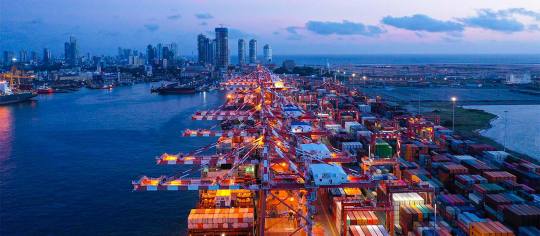
#South Asia Gateway Terminals#Sustainable Development Goals in Sri Lanka#Cargo Handling Equipment#Cargo Handling#Cargo Management#Terminal Managment#Best Service#Sri Lanka
0 notes
Text
Pity the Peruvian negotiators who, five years ago, signed an agreement with the Chinese giant Cosco Shipping Ports. The agreement was about the Port of Chancay, located near Lima, which was to become a megaport and “the gateway from South America to Asia,” as one Cosco manager told The Associated Press. But now, as the massive port nears completion, an “administrative error” by unnamed officials in Peru has given Cosco Shipping Ports exclusivity over operations at the Port of Chancay, the Peruvian port authority (APN) announced in March. Other infrastructure operators still hoping for large Chinese investments should pay heed.
That’s bad news, because the two-terminal construction is be completed later this year, and Peru has great expectations. Cosco acquired 60 percent ownership over the port when the deal was announced in 2019, and together with Peruvian mining company Volcan, it has invested a staggering $3.5 billion in the project, which intends to turn the natural deep-water port into a cargo megaport. The Peruvian government, though, assumed that the Chinese shipping giant would merely be using the port that it will majority-own, not have exclusive rights to it. But during the negotiations, Cosco somehow gained precisely these rights. Now APN is trying to rescind the exclusivity, saying it made a mistake.
Oh, to be a fly on the wall at APN headquarters or the office of new Peruvian new Economy Minister José Arista, who has to help sort this mess out. A mere five years ago, Cosco’s investment in Chancay, which is located a mere 40 miles to the north of the capital city of Lima, seemed to be unmitigatedly good news.
Chancay will indeed gain two massive terminals. There will be a new container terminal with 11 berths and new a four-berth terminal for bulk cargo, general cargo, and rolling cargo, World Cargo News reported. How many countries just happen to have a natural deep-water port in a strategic location and then manage to attract Chinese money to massively expand it?
In what seemed to be even better news for Peru, sailing from Chancay will dramatically cut the travel time for vessels headed to China from the region. That, of course, means increased revenues and regional power for Peru. So exciting was Chancay’s future that in March, Arista took Brazilian Planning Minister Simone Tebet to the port to discuss prospective Brazilian exports from it. Brazil—a major food-exporting nation—is interested in shipping soybeans and corn from Chancay, which would cut the transit time to Asia by some two weeks compared to the Panama Canal route, Reuters reported. (China is Brazil’s top buyer of soybeans.)
The joy was, alas, abruptly halted last month, when Cosco sent Arista’s Economy Ministry a letter disputing the contents of a message that it had received from APN. In its letter, the port authority had explained its “administrative error” and pointed out that it doesn’t have the authority to grant exclusive port access. The Chinese firm, though, is standing its ground, even implying that it could pull out if it doesn’t get exclusive access.
The Peruvian government may—like countless other governments in countries ranging from Italy to Sri Lanka that, until recently, enthusiastically courted Chinese infrastructure investments—simply have gotten cold feet about Cosco in Chancay, especially since Cosco is ultimately owned by the Chinese state through its mainland-based parent company, Cosco Shipping. Or APN may in fact have been outfoxed in the negotiations. Last year, the U.S. government told Lima that it was concerned about Chinese infrastructure control in Peru.
Either way, the Peruvian government is now in a massive bind, with the port scheduled to be completed and start operations at the end of this year.
That raises the question of how many other governments have enthusiastically negotiated agreements with Chinese infrastructure investors without understanding all the fine print.
According to research by the Council on Foreign Relations, Chinese firms have invested in 92 active ports outside China, including Hamburg, Rotterdam, and seven other EU ports as well as three in Australia. And 13 of those 92 ports, including two container terminals in Spain and Greece’s Port of Piraeus, have majority-Chinese ownership. In 10 ports with Chinese investments, the Council on Foreign Relations identified “physical potential for naval use.”
In the United States, meanwhile, security services have discovered secretly installed communications equipment in Chinese-built cargo cranes operating at U.S. ports. How many port projects that are not yet complete have unwittingly granted Chinese firms exclusive access? We likely have no way of knowing until they’re operational. But we may see more Chancays.
There are plenty of strategic reasons for these Chinese investments. At the Doraleh Container Terminal in Djibouti, the Chinese operator China Merchants Port Holdings (whose ultimate owner is also the Chinese state) is trying to dislodge the Emirati firm DP World from a long-standing contract granting the latter exclusive access. In 2017, the Chinese military opened its first overseas military base—also in Djibouti.
Many countries’ enthusiasm for China has waned. Last year, a Pew Research Center poll covering 24 countries across all inhabited continents found that a median of 67 percent of people viewed China unfavorably, compared to only 28 percent who viewed it favorably. That’s a dramatic increase from a median unfavorability rating of 41 percent that Pew found less than five years ago.
Such sentiments, though, are unlikely to discourage Chinese firms from trying to gain a stake in overseas infrastructure. In the Arctic Norwegian port town of Kirkenes (population: 3,404 people), located just 13 kilometers (8 miles) or so from the Russian border and home to the closest NATO port to Russia, no fewer than six Chinese companies are seeking to establish operations. The prospective investors include a textile manufacturer, an automotive manufacturer, a technology firm, an investment fund, a construction firm, and a shipping company.
Chinese firms are also interested in building and financing the Kirkenes Port, Norwegian National Radio reported. Kirkenes is, of course, also conveniently located near the Northern Sea Route, which goes along Russia’s Arctic coast and would slash the travel time for ships traveling from northern Europe to the Chinese East Coast or vice versa. The investment would be a big boost, but also raises security concerns for a town already on high alert. In February this year, a Russian citizen was arrested photographing military installations in Kirkenes.
Are Norwegian port representatives and other officials up to negotiating a complex deal with a Chinese company such as Cosco without giving away the store, should the suitors present a strong offer?
As attractive as Chinese money can be, let’s hope that strategic sense might sometimes prevail.
8 notes
·
View notes
Text
Rent property in Multan
Title: A Comprehensive Guide to Renting Property in Multan: Your Gateway to Comfortable Living
Multan, often referred to as the "City of Saints" and "Mango Capital of Pakistan," is not only rich in culture and history but also offers a vibrant lifestyle and diverse opportunities. As one of the oldest cities in South Asia, Multan attracts people from all walks of life, including students, professionals, and families, who seek to immerse themselves in its unique charm and warmth. If you're considering relocating to this beautiful city or simply looking for a new place to call home, renting property in Multan can be a promising venture. In this guide, we'll delve into everything you need to know about renting property in Multan, from popular neighborhoods to rental trends and tips for a smooth renting experience.
Understanding Multan's Neighborhoods
Before diving into the rental market, it's essential to familiarize yourself with Multan's diverse neighborhoods, each offering its own unique character and amenities. Here are some of the most sought-after areas for renting property in Multan:
Gulgasht Colony: Known for its peaceful environment and proximity to educational institutions, Gulgasht Colony is a preferred choice for families and students alike.
Bosan Road: This area is popular among those seeking modern amenities and convenient access to shopping centers, restaurants, and recreational facilities.
Cantt: Multan Cantonment, or Cantt, is renowned for its well-planned layout, green spaces, and upscale housing options, making it ideal for those looking for a premium living experience.
Shah Rukn-e-Alam Colony: Named after the famous Sufi saint, this neighborhood offers a blend of residential and commercial properties, along with a rich cultural heritage.
Wapda Town: With its well-developed infrastructure and family-friendly environment, Wapda Town is a favorite among middle to upper-income households.
Rental Trends in Multan
Multan's rental market is dynamic, with a wide range of options to suit various preferences and budgets. Here are some key trends to keep in mind:
Affordability: Compared to major cities like Lahore and Karachi, rental rates in Multan are relatively affordable, making it an attractive destination for those seeking quality accommodation without breaking the bank.
Property Types: From apartments and houses to commercial spaces and farmhouses, Multan offers a diverse range of rental properties to cater to different needs and lifestyles.
Demand: The demand for rental properties in Multan remains steady, driven by factors such as urbanization, migration, and the city's growing reputation as a commercial and educational hub.
Seasonal Variations: Like many cities, rental rates in Multan may fluctuate seasonally, with prices typically rising during peak moving seasons and major events.
Tips for Renting Property in Multan
Navigating the rental market can be daunting, especially for first-time renters. Here are some tips to help streamline the process and ensure a successful renting experience:
Define Your Requirements: Before you start your search, clearly outline your priorities, such as budget, location, amenities, and desired property type. This will help narrow down your options and save time.
Research Extensively: Take the time to research different neighborhoods, property listings, and rental prices to get a comprehensive understanding of the market dynamics.
Inspect the Property: Always conduct a thorough inspection of the property before signing any lease agreements. Look for any signs of damage or maintenance issues and discuss them with the landlord or property manager.
Understand the Lease Terms: Carefully review the lease agreement, paying attention to clauses related to rent, security deposit, maintenance responsibilities, and termination conditions. Seek clarification on any terms that are unclear or concerning.
Negotiate Wisely: Don't hesitate to negotiate the rent or lease terms, especially if you believe they are not favorable or in line with market standards. Be respectful but assertive in expressing your concerns and preferences.
Seek Legal Assistance if Necessary: If you're unsure about any aspect of the rental process or lease agreement, consider seeking advice from a legal professional specializing in property law to ensure your rights and interests are protected.
Final Thoughts
Renting property in Multan offers a gateway to comfortable living amidst a city steeped in history, culture, and modern amenities. By understanding the local market trends, exploring different neighborhoods, and following best practices for renting, you can find the perfect place to call home in this vibrant city. Whether you're a student, professional, or family, Multan welcomes you with open arms, promising an enriching and fulfilling living experience.
0 notes
Text
Top 20 Airports in terms of passengers in 2019:
1. **Hartsfield-Jackson Atlanta International Airport (ATL), USA**
- 2019 Passengers: Over 110 million
- Known for: The world's busiest airport by passenger traffic, serving as a major hub for domestic and international travel.
2. **Beijing Capital International Airport (PEK), China**
- 2019 Passengers: Over 100 million
- Known for: A key international gateway to China, noted for its massive Terminal 3, one of the largest airport terminals in the world.
3. **Los Angeles International Airport (LAX), USA**
- 2019 Passengers: Over 88 million
- Known for: A major gateway for international travelers to the U.S., especially from the Asia-Pacific region.
4. **Dubai International Airport (DXB), UAE**
- 2019 Passengers: Over 86 million
- Known for: The world's busiest airport by international passenger traffic and a major connecting hub between the East and the West.
5. **Tokyo Haneda Airport (HND), Japan**
- 2019 Passengers: Over 85 million
- Known for: Offering significant domestic flights alongside growing international connections, noted for efficiency and cleanliness.
6. **Chicago O'Hare International Airport (ORD), USA**
- 2019 Passengers: Over 84 million
- Known for: A major international hub, especially for flights between the East and West Coasts of the U.S.
7. **London Heathrow Airport (LHR), UK**
- 2019 Passengers: Over 80 million
- Known for: Europe's busiest airport by passenger traffic and a major hub for transatlantic flights.
8. **Shanghai Pudong International Airport (PVG), China**
- 2019 Passengers: Over 76 million
- Known for: A key international gateway to Shanghai and eastern China, with extensive cargo and passenger services.
9. **Paris Charles de Gaulle Airport (CDG), France**
- 2019 Passengers: Over 76 million
- Known for: The largest airport in France and a crucial hub for flights between the U.S., Europe, and Africa.
10. **Dallas/Fort Worth International Airport (DFW), USA**
- 2019 Passengers: Over 75 million
- Known for: A major hub for domestic and international flights, strategically located between the east and west coasts.
11. **Guangzhou Baiyun International Airport (CAN), China**
- 2019 Passengers: Over 73 million
- Known for: A rapidly growing hub, serving as a key gateway to southern China.
12. **Amsterdam Schiphol Airport (AMS), Netherlands**
- 2019 Passengers: Over 71 million
- Known for: A major European hub, famous for its single-terminal concept and extensive art collection.
13. **Hong Kong International Airport (HKG), Hong Kong**
- 2019 Passengers: Over 71 million
- Known for: A critical hub for international finance and trade, with extensive connections to mainland China and Asia.
14. **Seoul Incheon International Airport (ICN), South Korea**
- 2019 Passengers: Over 70 million
- Known for: Regularly awarded for its service quality, including a highly efficient transit process.
15. **Frankfurt Airport (FRA), Germany**
- 2019 Passengers: Over 70 million
- Known for: Germany's busiest airport and a key hub for flights between Europe and the rest of the world.
16. **Singapore Changi Airport (SIN), Singapore**
- 2019 Passengers: Over 68 million
- Known for: Consistently rated as one of the world's best airports, with exceptional services and amenities.
17. **Denver International Airport (DEN), USA**
- 2019 Passengers: Over 69 million
- Known for: The largest airport by land area in the U.S., serving as a major hub in the country's interior.
18. **Suvarnabhumi Airport (BKK), Thailand**
- 2019 Passengers: Over 68 million
- Known for: Serving as the main international gateway to Thailand, with a distinctive roof design.
19. **John F. Kennedy International Airport (JFK), USA**
- 2019 Passengers: Over 62 million
- Known for: A major international gateway to the U.S., especially for flights from Europe and Latin America.
20. **Kuala Lumpur International Airport (KUL), Malaysia**
- 2019 Passengers: Over 62 million
- Known for: An important hub for Southeast Asia, noted for its modern design and efficiency.
These airports are not just transportation nodes but complex ecosystems that support millions of jobs, drive economic growth, and connect the global community. Their rankings and passenger numbers are a testament to their importance in the global air transport network.

0 notes
Text
Indira Gandhi International Airport: A Beacon of Connectivity in South Asia
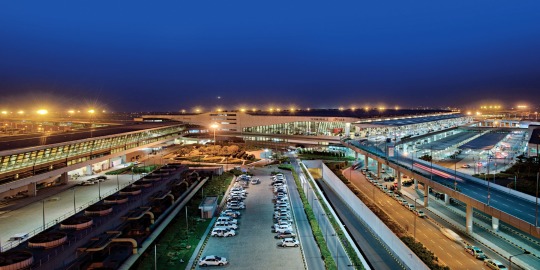
Indira Gandhi International Airport (IGIA), situated in the heart of India's capital, New Delhi, serves as a bustling gateway not only to the nation but to the entire South Asian region. This sprawling airport, named after the iconic former Prime Minister of India, Indira Gandhi, holds a central position in the global aviation landscape. In this article, we will delve into the significance of IGIA as a critical transportation hub, its role in regional connectivity, and the sustainability initiatives it has undertaken.
Regional Connectivity Hub
IGIA has evolved into a key player in South Asia's air travel ecosystem. Its strategic location connects major cities within India and serves as a vital transit point for international travelers heading to destinations across Asia, Europe, North America, and beyond. The airport's three terminals—T1, T2, and T3—handle a staggering number of passengers and flights daily, making it one of the busiest airports in the world.
One of IGIA's distinctive features is its ability to facilitate seamless travel within South Asia. It offers direct flights to numerous neighboring countries, enhancing economic and cultural ties in the region. This connectivity extends beyond India's borders to countries like Nepal, Bhutan, Sri Lanka, Bangladesh, and the Maldives, fostering regional cooperation and exchange.
Modern Infrastructure and Services
IGIA's relentless commitment to enhancing the passenger experience is reflected in its modern infrastructure and top-notch services. The airport's terminals are equipped with cutting-edge technology, automated check-in kiosks, efficient baggage handling systems, and world-class lounges catering to the diverse needs of travelers.
Terminal 3 (T3), in particular, stands as a masterpiece of architectural design and functionality. It showcases India's capability to deliver a world-class airport experience, complete with luxury retail outlets, dining options, and entertainment facilities. T3's eco-friendly features, such as its energy-efficient lighting and waste management systems, highlight the airport's commitment to sustainable practices.
Sustainability Initiatives
IGIA recognizes the importance of sustainability and has taken several measures to minimize its environmental footprint. The airport has implemented various initiatives to reduce energy consumption, lower greenhouse gas emissions, and conserve water resources. A significant step in this direction is the installation of solar panels across the airport premises, making it one of the largest solar-powered airports in the world.
Moreover, Indira Gandhi International Airport places a strong emphasis on waste management and recycling programs. Efforts are made to minimize the generation of non-recyclable waste and encourage sustainable practices among airport staff and partners.
Economic Impact and Growth
The economic significance of IGIA extends far beyond its role as a transportation hub. The airport generates substantial revenue and provides employment opportunities for thousands of people, including airline staff, security personnel, retail employees, and more. It also supports a thriving ecosystem of businesses, from hotels and restaurants to transportation services, in the surrounding areas.
Furthermore, IGIA's role in promoting tourism cannot be overstated. It serves as the primary point of entry for international tourists exploring India's rich cultural heritage, historical sites, and diverse landscapes. The airport's growing passenger numbers continue to contribute to the country's economic growth by fostering tourism, trade, and investment.
Conclusion
Indira Gandhi International Airport stands as a symbol of India's commitment to connectivity, regional cooperation, and sustainability in the field of aviation. It plays a pivotal role in connecting not only India but also the entire South Asian region to the rest of the world. As it continues to evolve and expand, IGIA remains a testament to India's rise on the global stage and its dedication to fostering economic growth and cultural exchange.
1 note
·
View note
Text
Top 10 most beautiful airports in the world

Airports, often seen as mere gateways to destinations, are rarely associated with beauty or aesthetics. However, hidden among the hustle and bustle of modern air travel, some airports stand out like shimmering gems in the concrete jungle. These architectural marvels serve as functional transport hubs and take our breath away with their stunning designs and innovative concepts. From futuristic terminals that resemble spaceships to ancient structures seamlessly blending tradition with modernity, these airports redefine our perception of what an airport can be. Join us worldwide as we explore some of the most beautiful airports in the world that will leave you awe-inspired before you board your flight.
List of Some of the Most Beautiful Airports in the World
Airports are no longer just functional buildings to transport people from one place to another. They have transformed into architectural marvels that showcase innovation, creativity, and beauty. From sleek modern designs to stunning natural landscapes, airports around the world have taken on a whole new level of aesthetic appeal. In this article, we will explore some of the most beautiful airports in the world that leave visitors spellbound with their captivating designs and awe-inspiring surroundings.
Changi International Airport, Singapore
Changi Airport, nestled amidst the lush greenery and vibrant colors of Singapore, stands as a testament to the country's commitment to excellence. It is undoubtedly one of the most beautiful airports in the world. With its state-of-the-art architecture and stunning gardens, this tropical paradise offers a unique experience that goes beyond ordinary transit hubs. As you step into the terminals, you are greeted by a breathtaking sight - the world's tallest indoor waterfall cascading down from a lush vertical garden. The Jewel Changi Airport, as it is called, is a mesmerizing masterpiece where nature intertwines seamlessly with modern infrastructure.
Private Singapore City Highlights Tour by Car
To truly immerse yourself in the serenity of this tropical oasis, take some time to explore its hidden gems - the rooftop gardens dotted along various parts of the airport. Lush green spaces adorned with colorful flowers provide solace amidst the bustling terminals. Embark on a stroll through their carefully curated paths or find a quiet spot to unwind while enjoying panoramic views of planes landing and taking off against a backdrop of clear blue skies. All these things make it one of the most beautiful airports in the world.
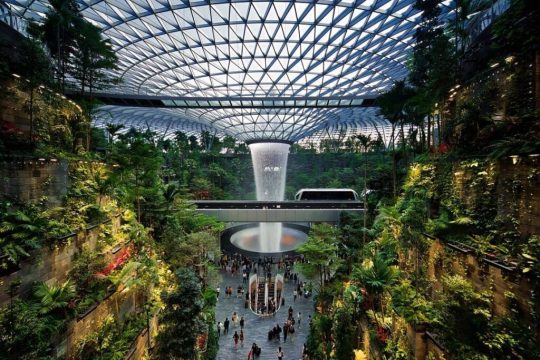
Changi International Airport, Singapore
Incheon International Airport, South Korea
Nestled on an island just west of Seoul, Incheon International Airport South Korea is a marvel of modern design and functionality. From the moment you step foot inside its sleek and minimalist terminal, you can't help but be awed by its elegant beauty. The airport's massive glass windows flood the space with natural light, creating an airy and open atmosphere that immediately puts travelers at ease.
Explore the beauty of South Korea through group and solo tours
But it's not just the aesthetics that make Incheon International Airport stand out among other airports around the world. Its seamless integration of technology is equally impressive. From self-check-in kiosks to automated immigration systems, every corner of this airport seems to be imbued with forward-thinking innovation.
Top 10 cheapest places to fly into Europe
Overall, Incheon International Airport showcases South Korea's commitment to excellence in both design and service. With its combination of stunning architecture, technological advancements, and top-notch amenities, it certainly deserves its place among the most beautiful airports in the world. So next time you find yourself traveling through Asia, make sure to include a layover at this architectural gem - because even airports can provide unforgettable experiences.
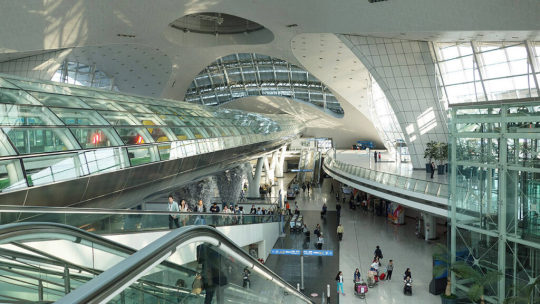
Incheon Airport Train Terminal, Korea
Dubai International Airport, UAE
Dubai International Airport in the United Arab Emirates has garnered much attention for its extravagant luxury, setting itself apart as one of the most beautiful airports in the world. It Has been selected as the best airport in the Middle East Multiple times. The airport boasts stunning architecture and state-of-the-art facilities that create an unparalleled sense of opulence upon arrival.
Not only is Dubai International Airport visually spectacular, but it also offers a plethora of amenities for travelers looking for a touch of extravagance. Luxury lounges provide ultimate comfort with plush seating, gourmet cuisine, and even spa treatments to rejuvenate weary travelers. High-end shops featuring international brands line the concourses, offering visitors access to designer fashion, jewelry, and electronics – all under one roof.
Explore the beauty of Dubai
Dubai International Airport showcases extravagant luxury on a scale rarely seen elsewhere. Its awe-inspiring architecture, top-notch facilities, and lavish amenities make it deserving of its reputation as one of the most beautiful airports in the world. As travelers pass through its doors and immerse themselves in an atmosphere filled with elegance and sophistication, they are treated to an experience unlike any other - truly living up to Dubai's reputation as a city where luxury knows no bounds.
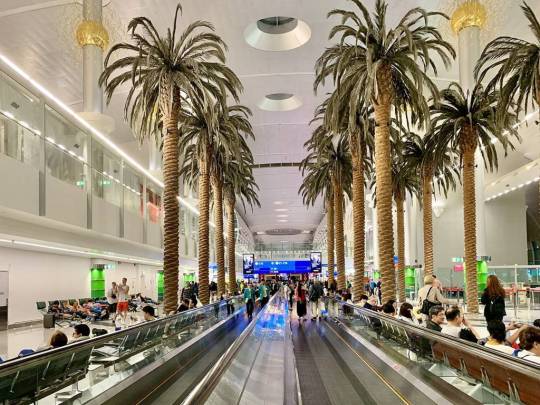
Dubai International Airport interior of Terminal 3
Hamad International Airport, Qatar
Hamad International Airport in Doha, Qatar is an architectural marvel that seamlessly blends modern design with traditional Arabian influences. Boasting a striking terminal building shaped as a desert rose, this airport captivates visitors even before they step inside. The intricately designed facade combines glass, steel, and concrete to create an ethereal effect, reflecting the surrounding desert landscape.
Once inside, passengers are greeted with a vast interior space adorned with local artwork and sculptures. The airport's expansive layout allows for easy navigation, while its soothing color palette of earth tones creates a calm ambiance amid the bustling crowds. Unique features such as a tropical garden and a 25-meter indoor swimming pool provide travelers with a welcome retreat from their journeys.
Explore Qatar by booking private and group tours here
The attention to detail at Hamad International Airport is evident in every aspect - from its luxurious lounges offering panoramic views of the runways to its technologically advanced facilities such as self-check-in kiosks and automated baggage handling systems. It seamlessly combines functionality with aesthetics, ensuring that every traveler's experience is both efficient and enjoyable. So, Qatar has rightfully earned its place as one of the most beautiful airports in the world.
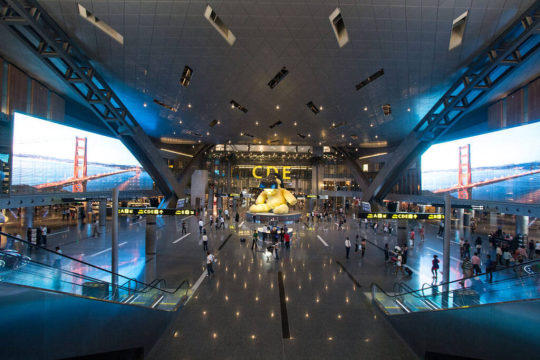
Hamad International Airport Doha, Qatar
Denver International Airport, USA
One of the most beautiful airports in the world, Denver International Airport (DIA) stands out for its unique nature-inspired design. It is the second-largest airport in the world and the most significant in the USA. Situated amidst the picturesque landscapes of Colorado, this airport seamlessly integrates with its surroundings and captures the essence of nature. DIA boasts an expansive layout miming a bird's-eye view of rivers winding through fields and farmlands, offering travelers a serene and calming atmosphere.
The iconic terminal roof resembles snow-capped mountains, paying homage to Colorado's majestic peaks while bringing a touch of natural wonder inside the airport. DIA showcases an impressive collection of artworks inspired by natural elements. Crafted by local artists, these installations capture the essence of Colorado's diverse landscapes – from dramatic mountain ranges to expansive plains dotted with wildflowers. Travelers are treated to a visually captivating experience as they explore various parts of the airport.
Private Day Tour from Denver to Estes Park and Rocky Mountain National Park
Overall, Denver International Airport truly embodies nature-inspired design at its finest. Its seamless integration with Colorado's landscape coupled with stunning artworks makes every visit feel like stepping into an artistic haven surrounded by breathtaking views. You surely come and visit this one of the most beautiful airports in the world.

Denver International Airport
Beijing Daxing International Airport, China
Located on the outskirts of Beijing, China the Daxing International Airport is a marvel of modern engineering and architecture. Designed by renowned architect Zaha Hadid, this airport is not only functional but also aesthetically pleasing. The airport is nicknamed “Starfish” for its shape and futuristic design making it one of the most beautiful airports in the world. All five concourses of Beijing Airport are connected to the main hall and Ground Transportation Centre. The natural light streaming through the skylights creates a serene ambiance that calms even the most anxious traveler.
2-Day Beijing Highlights and Great Wall Tour
What sets Beijing Daxing apart from other airports is its dedication to sustainability and environmental-friendliness. The building's distinctive design enhances natural lighting while reducing energy consumption. Additionally, intelligent ventilation systems help regulate indoor temperature without excessive energy usage. These features showcase not only the airport's commitment to sustainable practices but also provide a refreshing atmosphere for travelers.
Exploring the benefits of Air Taxi services
Overall, Beijing Daxing International Airport offers travelers a breathtaking experience from start to finish. Its combination of architectural excellence and environmental consciousness makes it deserving of a spot among the most beautiful airports in the world. Whether you are an architecture enthusiast or simply someone looking for a seamless travel experience, this airport promises to leave you inspired and eager to explore more upon arrival in Beijing.
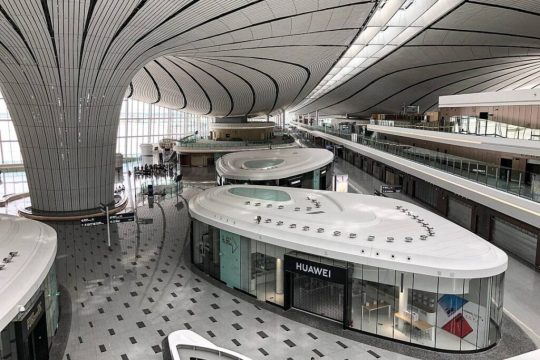
Concourse of Beijing Daxing International Airport
Munich International Airport, Germany
Located near the town of Freising, Munich International Airport is renowned for its exceptional design and efficient operations. As one of the busiest and the beautiful airports in Europe, it seamlessly blends modernity with tradition, making it a true gem among airport terminals. The stunning architecture incorporates sleek glass facades, high ceilings, and spacious interiors that create an ambiance of grandeur upon arrival.
One unique feature of Munich International Airport is its extensive collection of art exhibitions scattered throughout the terminal buildings. From sculptures to paintings to multimedia installations, these carefully curated displays offer passengers an opportunity to engage with art while waiting for their flights. Whether it's a thought-provoking sculpture or a captivating photograph, each piece adds depth and creativity to the airport experience.
Private trip from Munich to Eagle's Nest, and Salzburg
Additionally, Munich International Airport boasts not only excellent shopping options but also an impressive selection of dining establishments. From local Bavarian cuisine to international flavors from around the world, there truly is something for everyone. And with cozy seating areas where you can enjoy your meal. So, Munich International Airport undoubtedly deserves its place among the most beautiful airports in the world.
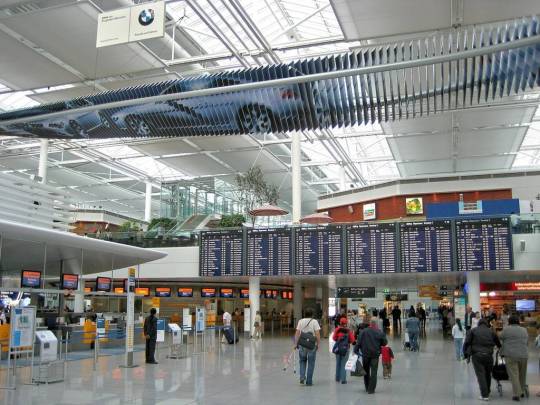
Munich International Airport, Germany
Hong Kong International Airport, China
Located on the island of Chek Lap Kok, Hong Kong International Airport is not just a transit hub but an architectural wonder that impresses travelers from the moment they step foot inside. The airport's design combines functionality and creativity, with bright open spaces adorned with striking modern artworks. From the vast check-in halls to the expansive boarding areas, every corner of this airport exudes a sense of grandeur and efficiency. No wonder it has been consistently ranked as one of the most beautiful airports in the world.
Private Full-Day Hong Kong Island Top Attraction Tour
Hong Kong International Airport has rightfully earned its place among the world's most beautiful airports due to its exceptional architecture, extraordinary facilities like SkyMart, and awe-inspiring views from observation decks. From impressive design to an extensive range of amenities catering to all kinds of travelers' needs, this airport has redefined what it means to be more than just a transport hub—it's an attraction in itself.
From high-end shopping outlets to Michelin-starred restaurants, there's something for everyone here. Don't miss out on exploring the SKYCITY Nine Eagles golf course adjacent to Terminal 2 if you're looking for some outdoor recreation or simply want to indulge your passion for the sport amidst this urban airport oasis. So, come and visit the most beautiful airports in the world.
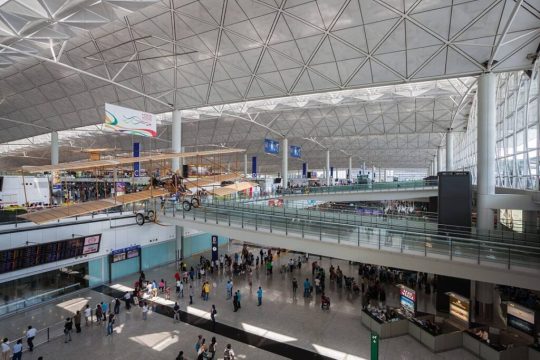
Hong Kong International Airport
Heydar Aliyev International Airport Baku, Azerbaijan
Heydar Aliyev International Airport in Baku is a masterpiece of architectural design that simply cannot be ignored when talking about the most beautiful airports in the world. The airport's sleek and modern façade is a testament to the innovative nature of Azerbaijan, blending seamlessly with its surroundings. Walking through the airport feels like strolling through an art gallery, with stunning contemporary artwork adorning every corner.
5 days in Azerbaijan - North & South
Inside Heydar Aliyev International Airport, passengers are greeted by spacious interiors and an abundance of natural light flooding in through floor-to-ceiling windows.
Read the full article
#beautifulairports#mostbeautifulairports#mostbeautifulairportsintheworld#mostbeautifulairportsofworld#worldmostbeautifulairports
0 notes
Photo

A Chinese-backed port project in Peru should become the gateway from South America to Asia, according to officials. The new port, located in the city of Ilo, is being funded by the Chinese government and is expected to be completed in 2020. It will have a total of five docks, including a container terminal, and will be able to handle up to four million containers a year. The port is part of a larger project that includes a free trade zone, a new airport, and a highway that will connect Ilo to the rest of Peru.
0 notes
Text
Unlock the Best Deals on Delhi to Mumbai Flights

With My Flight Trip, you can get the most affordable flights from Delhi to Mumbai. We provide the most affordable airline tickets together with fantastic discounts. Major domestic carriers including Indigo, Go Air, Spice Jet, Air Asia, Air India, and Vistara operate regular flights. With an average ticket of INR 3,000 and a journey time of 2 hours and 20 minutes, round-trip bookings are more economical than one-way fares. For the most affordable rate, make your booking right away. Furthermore, keep reading this blog to know more about Delhi to Mumbai flight information.
About New Delhi:
The capital of India and the largest commercial center in northern India is New Delhi. The city has a major governmental environment, a fantastic way of life, and a rich history. It serves as the majority of foreign embassies' and significant government organizations’ administrative hubs. The city is home to several historic buildings, temples, vibrant local markets, and open-round-the-clock cafés that draw both domestic and foreign tourists. A welcoming, happy, and proud city, New Delhi has something special to offer everyone.
Best time to visit New Delhi:
The best time to visit the city is from October to March when the weather is comfortable and suitable for sightseeing.
Delhi Airport Insights:
Indira Gandhi International Airport (DEL) is Delhi's primary airport. It handles approximately 35 million people annually, making it India's busiest airport. The airport is becoming a significant transportation hub in South Asia with both local and international aircraft departing from it. The quantity of flights has increased as a result. Through My Flight Trip, you can book your flight tickets from Delhi to Mumbai and take pleasure in a relaxing journey.
A brief about Mumbai and some of the places to visit:
The capital of Maharashtrais Mumbai. It is the seventh most populated city in the world and is sometimes referred to as the "city of dreams" since so many people from rural areas travel here to achieve their ambitions. Mumbai is the wealthiest city in India thanks to its high concentration of millionaires and billionaires. It is one of the top 10 worldwide business hubs and a prominent financial and commercial center. It is renowned for its entertainment sector as well.
Make sure to visit these below mentioned places whenever you’re in Mumbai:
Gateway of India
Juhu Beach
Elephanta Caves
Marine Drive
Sri Siddhi Vinayak Ganpati Mandir
Mumbai Airport Insights:
After Delhi, Mumbai airport is the busiest airport in India. In terms of handling aviation passengers in 2017, it was rated 28th in the globe and 14th in Asia. Additionally, it handles cargo better than any other airport in India, ranking second. The airport operates more than 900 passenger and freight flights per day out of its three terminals. Mumbai Airport broke a record in December 2018 by handling 1007 planes. It received the title of "Best Airport in India and Central Asia" in 2016.You can purchase Mumbai flight tickets right now and take advantage of amazing discounts.
Choosing My Flight Trip will help you attain exclusive deals, here’s how:
My Flight Trip provides you with the option of choosing from a wide range of airlines available. You can compare Delhi to Mumbai flight fares and choose the best according to your budget and schedule. Moreover, besides the easy booking process and impressive discounts and offers, My Flight Trip also provides 24*7 customer assistance which makes everything hassle-free.
#Flights Delhi To Mumbai#delhi to mumbai international flight#Flight Tickets From Delhi To Mumbai#flight tickets from delhi to mumbai#flights from delhi to mumbai#Book Delhi to Mumbai Flights#cheap flights delhi to mumbai
0 notes
Photo

A Crypto ATM is a terminal that allows investors to buy or sell cryptos such as Bitcoin, Ethereum, and other altcoins by using cash transactions, bank cards, and payment gateways.
In recent years, there is an upsurge in public responsiveness about crypto supporting the usage of crypto ATMs. The COVID-19 pandemic had a slight impact on the crypto industry, but the industry witnessed a positive rise in the first financial quarter of 2021 as crypto ATMs enabled customers to transfer and receive crypto online without requiring any physical contact.
Rise of Global Crypto ATM
Bitcoin (BTC) ATMs are garnering popularity for assuring ultimate financial confidentiality being tamper-proof and providing an instant way to buy or sell crypto’s. Bitcoin ATMs ensure ultimate security as users need not attach their personal information. Cryptos can be transferred only if the user shares their accurate security credentials. These ATMs are fortified to protect against software and hardware malfunction.
The German crypto ATM market experienced a CAGR of 55% due to the tax benefits for crypto transactions. The cryptos are tax-free if the total profit from private transactions in a year is less than USD 709 and crypto sales held for more than a year are exempted from tax.
The market share of the crypto ATM scanners is improved so that investors can easily set up their wallets and find the wallet address for inbound transactions. Crypto ATMs can do it automatically by scanning the QR code on the smartphone screen instead typing the code manually. This could lead to mistakes and fund loss.
Currently, there are more than 39,000 BTC ATMs all over the world. There are two types of BTC ATMs: Basic ATMs allowing the users only to purchase Bitcoins and Complex ATMs that enable buying and selling of virtual money.
The growing demand for two-way ATMs in the United States (US) market may rise more than 50% through 2028. Crypto ATMs provide features such as high security and multi-crypto funding, for increasing crypto sales at premium prices. The US is perceiving a rise in the adoption of two-way ATMs.
The Asia Pacific crypto ATM market accounts for 10% of the global revenue share in 2021. India and South Korea are investing in startups for accelerating the market expansion of crypto exchanges.
Despite being criticized for lacking regulatory clarity in the Web3 sector, the US currently leading the frontline of bitcoin ATM adoption.
Top Countries Holding Crypto ATMs :
1. United States - 33,549
2. Canada - 2,559
3. Europe - 1,502
4. Australia - 218
5. Poland - 150
6. Spain - 226
7. Switzerland - 145
The major factors that drive the market growth of crypto ATMs are
1. Increase in acceptance of cryptos as a mode of payment
2. Deployment of crypto ATMs in public locations
3. Rise in the usage of two-way crypto ATMs
Also, crypto ATMs ensure rapid transactions so that users receive cash comparatively faster. Crypto ATMs are easy to use and have a simple step-by-step process to help users execute transactions conveniently. The evolving focus of crypto ATM providers on security enhancements to combat potential cyberattacks and ensure secure transactions are additional factors contributing to the revenue growth of the market.
Prospects for key players
Governments across the globe are increasingly focusing on installing crypto ATMs as more and more businesses are shifting toward the crypto ecosystem to meet the growing demand of customers. The increase in the number of collaborations between crypto ATM providers and government bodies to increase global crypto ATM networks is anticipated to increase potential opportunities for key players in the market. Also, the growing emphasis on reducing the scope of boosting compliance and improving the verification feature of crypto ATMs to prevent fraudulent activities and crypto-based criminal activities are expected to open up new paths for major companies and drive market growth.
The road forward
With a significant upsurge in global crypto adoption, many countries are seeking to enhance knowledge and spread cognizance regarding the benefits of cryptos. Propelled by its abundant progression, users are turning to easier and more convenient ways of crypto transactions, which is irrefutably setting off new opportunities for crypto ATMs. Current developments and technological advancements in crypto ATMs would shoot industry growth in the future with more investments by crypto leaders and market shareholders.
0 notes
Text
Twilight at the Terminal!
A stunning sunset at South Asia Gateway Terminals, one of the leading container terminals in the world at the Port of Colombo. With its advanced equipment and systems, cutting-edge technology and dedicated workforce, this South Asian container terminal continues to take maritime shipping to the next level.

#South Asia Gateway Terminals#Cargo Handling Equipment#Cargo Handling#Cargo Management#Terminal Managment#Best Service#Sri Lanka
0 notes
Text
Describe the Container transportation types.
Container shipments are divided into categories based on how many recipients they will reach:
Full container load (FCL). FCL shipping refers to a shipment that must be received by a single receiver, regardless of whether the maximum weight or volume has been attained. When sending huge quantities of items to a single recipient, this sort of shipment is typically preferred;
LCL (Less Than Container Load) refers to a partial load container, which is used when a container is not used exclusively for the cargo. If the amount of products to be delivered is insufficient to fill a normal container, the load is grouped with other loads for the same destination in a Container Freight Station. In this situation, the rental can be set up to accommodate numerous recipients.

Considering that cargo shipping containers make up a large portion of global logistics major international ports have terminals specifically designed for loading and unloading containers and transferring them to trains or trucks.
Some ports have evolved into "hubs," or locations with the biggest concentration of containers traveling on domestic or international routes, particularly from or to South-East Asia, Europe, and North America. Logistics hubs play a big part in transport logistics today, and their importance is only growing, especially in terms of administration and handling. However, there are other important transport logistics hubs as well, in addition to the huge seaports, public inland ports, and airports that frequently serve as key gateways for the import and export of products.
Additionally, there are a sizable number of less significant but nonetheless significant logistics hubs, such as the transport logistics hubs of freight forwarding networks. The containers are then picked up and transported to smaller ports after having been stuffed into the hubs. So that's why it's important to monitor or track cargo shipping containers.
In conclusion, there are many different types of containers that can be used depending on the specifics of the goods: refrigerated containers, tank containers, flat racks, open tops, or open sides. This method of transport, which was developed after the Second World War, is the most popular worldwide and can be essential to the strategy of a successful logistics process. If you are looking for freight services, contact Agora freight freely.
0 notes
Text
Benefits of Setting Up Company in Ho Chi Minh City
Ho Chi Minh City is considered as Vietnam’s economic hub. During the long history of foundation and development, the city’s economy is growing constantly and motivating the development of the country.
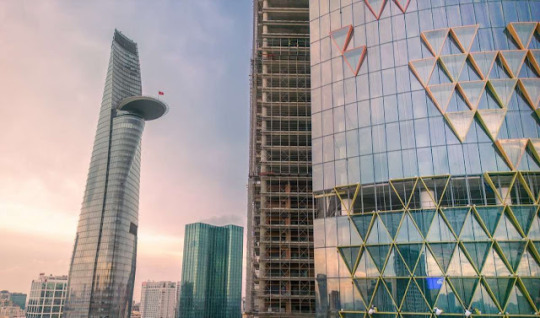
Setting up company in Vietnam
The city is therefore considered as a potential investment environment for domestic investors as well as foreign investors. The investment through establishing companies and conducting business activities in Ho Chi Minh city certainly promises to achieve multiple benefits. These benefits come from the following reasons.
First, Ho Chi Minh City has strategic location advantage in Vietnam. Southeast Asia Region, Ho Chi Minh City is 1,700 km south of Hanoi, 297 km east of Phnom Penh, Cambodia, 881 km east of Bangkok, Thailand.
Food, glass, textiles, paper products, plastics, chemicals, building materials and machinery are produced here. Ho Chi Minh City accounts for 20% of total gross domestic product (GDP), 30% of industrial production and 40% of export products of Vietnam. The city also accounts for 33% of the national budget and 60% of foreign investment flows into the region. In the past few years, the economy have been grown at a rate greater than 10% (6% to 8% nationally).
Second, Ho Chi Minh City is home of well – qualified, abundant and young human resources.
With a population of more than 8 million, accounting for more than 10% of the total Vietnamese population, Ho Chi Minh City itself has potential employment market to make any business investment. The work force in Ho Chi Minh City was estimated to reach 4.7 million people in 2012, making up more than 50% of the total population of the city. The percentage of trained labor increased from 40% in 2005 to 55% in 2010 and was forecast to reach 70% in 2015. The percentage of labor source holding postgraduate degree is also increasing year by year and most of them tend to stay in the city after holding degrees. Ho Chi Minh City is also home to more than 80 universities and colleges, vocational schools with over 400,000 students providing an abundant trained work force.
With the above – mentioned abundant labor force, any companies set up in Ho Chi Minh City can easily recruit suitable employees in a short time..
Third, the city has modern and high infrastructure system. Namely, when setting up company in Vietnam, the owners will benefit from the modern and comprehensive infrastructure system.
Tan Son Nhat Airport is the largest airport in the country with the capacity to accommodate 20 million people a year. From Tan Son Nhat Airport, there are 50 routes to other countries all over the world such as China, Japan, Korea, Singapore, European countries, etc.
Saigon Port serves as a gateway to the Mekong River Delta, the South China Sea (83 km away from the sea) and the Asia continent. The port has a total area of 500,000 m2 with 5 terminals meeting the international standards, and it handles about 8.3 million tons of cargo annually. Throughout the history of foundation and development of Saigon, Saigon Port plays an important role in making Ho Chi Minh City a flourishing trading center. It accounts for a fifth of the nation’s Gross Domestic Product and almost a third of its industrial production.
Ho Chi Minh City is also home to industrial zones. According to the statistics of Cushman & Wakefield, the city has 18 industrial parks that are operating with a total area of 3635 ha. When investing in such industrial zones in Vietnam, enterprises can benefit from various incentive policies such as low rate tax or other incentive policies.
Telecommunication and information technology in the city is modern. The system of post and telecommunication in Ho Chi Minh meets international standard, providing fast, reliable and high quality services such as ADSL, rapid data transfer, wide broadband MAN. The Internet service in Ho Chi Minh city is also among the cheapest in the world.
Besides, the city is also considered the best working conditions. Enterprise will not be fear that it is not enough place for working. The city with the system of offices provide ideal working environment for all investors.
With highly professional staff and great experience in business in Vietnam, ANT Lawyers would like to support you in establish company in Vietnam.
1 note
·
View note
Text
Benefits of Setting Up Company in Ho Chi Minh City
Ho Chi Minh City is considered as Vietnam’s economic hub. During the long history of foundation and development, the city’s economy is growing constantly and motivating the development of the country.
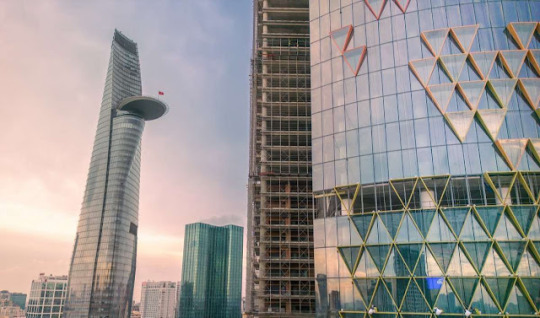
Setting up company in Vietnam
The city is therefore considered as a potential investment environment for domestic investors as well as foreign investors. The investment through establishing companies and conducting business activities in Ho Chi Minh city certainly promises to achieve multiple benefits. These benefits come from the following reasons.
First, Ho Chi Minh City has strategic location advantage in Vietnam. Southeast Asia Region, Ho Chi Minh City is 1,700 km south of Hanoi, 297 km east of Phnom Penh, Cambodia, 881 km east of Bangkok, Thailand.
Food, glass, textiles, paper products, plastics, chemicals, building materials and machinery are produced here. Ho Chi Minh City accounts for 20% of total gross domestic product (GDP), 30% of industrial production and 40% of export products of Vietnam. The city also accounts for 33% of the national budget and 60% of foreign investment flows into the region. In the past few years, the economy have been grown at a rate greater than 10% (6% to 8% nationally).
Second, Ho Chi Minh City is home of well – qualified, abundant and young human resources.
With a population of more than 8 million, accounting for more than 10% of the total Vietnamese population, Ho Chi Minh City itself has potential employment market to make any business investment. The work force in Ho Chi Minh City was estimated to reach 4.7 million people in 2012, making up more than 50% of the total population of the city. The percentage of trained labor increased from 40% in 2005 to 55% in 2010 and was forecast to reach 70% in 2015. The percentage of labor source holding postgraduate degree is also increasing year by year and most of them tend to stay in the city after holding degrees. Ho Chi Minh City is also home to more than 80 universities and colleges, vocational schools with over 400,000 students providing an abundant trained work force.
With the above – mentioned abundant labor force, any companies set up in Ho Chi Minh City can easily recruit suitable employees in a short time..
Third, the city has modern and high infrastructure system. Namely, when setting up company in Vietnam, the owners will benefit from the modern and comprehensive infrastructure system.
Tan Son Nhat Airport is the largest airport in the country with the capacity to accommodate 20 million people a year. From Tan Son Nhat Airport, there are 50 routes to other countries all over the world such as China, Japan, Korea, Singapore, European countries, etc.
Saigon Port serves as a gateway to the Mekong River Delta, the South China Sea (83 km away from the sea) and the Asia continent. The port has a total area of 500,000 m2 with 5 terminals meeting the international standards, and it handles about 8.3 million tons of cargo annually. Throughout the history of foundation and development of Saigon, Saigon Port plays an important role in making Ho Chi Minh City a flourishing trading center. It accounts for a fifth of the nation’s Gross Domestic Product and almost a third of its industrial production.
Ho Chi Minh City is also home to industrial zones. According to the statistics of Cushman & Wakefield, the city has 18 industrial parks that are operating with a total area of 3635 ha. When investing in such industrial zones in Vietnam, enterprises can benefit from various incentive policies such as low rate tax or other incentive policies.
Telecommunication and information technology in the city is modern. The system of post and telecommunication in Ho Chi Minh meets international standard, providing fast, reliable and high quality services such as ADSL, rapid data transfer, wide broadband MAN. The Internet service in Ho Chi Minh city is also among the cheapest in the world.
Besides, the city is also considered the best working conditions. Enterprise will not be fear that it is not enough place for working. The city with the system of offices provide ideal working environment for all investors.
With highly professional staff and great experience in business in Vietnam, ANT Lawyers would like to support you in establish company in Vietnam.
0 notes
Text
Benefits of Setting Up Company in Ho Chi Minh City
Ho Chi Minh City is considered as Vietnam’s economic hub. During the long history of foundation and development, the city’s economy is growing constantly and motivating the development of the country.
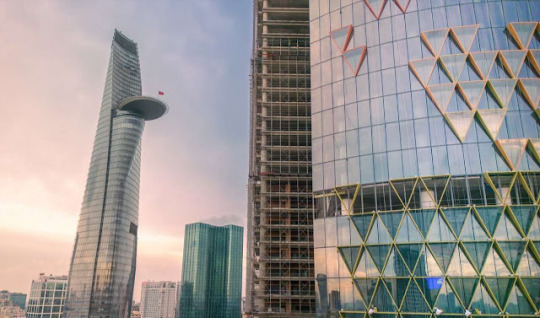
Setting up company in Vietnam
The city is therefore considered as a potential investment environment for domestic investors as well as foreign investors. The investment through establishing companies and conducting business activities in Ho Chi Minh city certainly promises to achieve multiple benefits. These benefits come from the following reasons.
First, Ho Chi Minh City has strategic location advantage in Vietnam. Southeast Asia Region, Ho Chi Minh City is 1,700 km south of Hanoi, 297 km east of Phnom Penh, Cambodia, 881 km east of Bangkok, Thailand.
Food, glass, textiles, paper products, plastics, chemicals, building materials and machinery are produced here. Ho Chi Minh City accounts for 20% of total gross domestic product (GDP), 30% of industrial production and 40% of export products of Vietnam. The city also accounts for 33% of the national budget and 60% of foreign investment flows into the region. In the past few years, the economy have been grown at a rate greater than 10% (6% to 8% nationally).
Second, Ho Chi Minh City is home of well – qualified, abundant and young human resources.
With a population of more than 8 million, accounting for more than 10% of the total Vietnamese population, Ho Chi Minh City itself has potential employment market to make any business investment. The work force in Ho Chi Minh City was estimated to reach 4.7 million people in 2012, making up more than 50% of the total population of the city. The percentage of trained labor increased from 40% in 2005 to 55% in 2010 and was forecast to reach 70% in 2015. The percentage of labor source holding postgraduate degree is also increasing year by year and most of them tend to stay in the city after holding degrees. Ho Chi Minh City is also home to more than 80 universities and colleges, vocational schools with over 400,000 students providing an abundant trained work force.
With the above – mentioned abundant labor force, any companies set up in Ho Chi Minh City can easily recruit suitable employees in a short time..
Third, the city has modern and high infrastructure system. Namely, when setting up company in Vietnam, the owners will benefit from the modern and comprehensive infrastructure system.
Tan Son Nhat Airport is the largest airport in the country with the capacity to accommodate 20 million people a year. From Tan Son Nhat Airport, there are 50 routes to other countries all over the world such as China, Japan, Korea, Singapore, European countries, etc.
Saigon Port serves as a gateway to the Mekong River Delta, the South China Sea (83 km away from the sea) and the Asia continent. The port has a total area of 500,000 m2 with 5 terminals meeting the international standards, and it handles about 8.3 million tons of cargo annually. Throughout the history of foundation and development of Saigon, Saigon Port plays an important role in making Ho Chi Minh City a flourishing trading center. It accounts for a fifth of the nation’s Gross Domestic Product and almost a third of its industrial production.
Ho Chi Minh City is also home to industrial zones. According to the statistics of Cushman & Wakefield, the city has 18 industrial parks that are operating with a total area of 3635 ha. When investing in such industrial zones in Vietnam, enterprises can benefit from various incentive policies such as low rate tax or other incentive policies.
Telecommunication and information technology in the city is modern. The system of post and telecommunication in Ho Chi Minh meets international standard, providing fast, reliable and high quality services such as ADSL, rapid data transfer, wide broadband MAN. The Internet service in Ho Chi Minh city is also among the cheapest in the world.
Besides, the city is also considered the best working conditions. Enterprise will not be fear that it is not enough place for working. The city with the system of offices provide ideal working environment for all investors.
With highly professional staff and great experience in business in Vietnam, ANT Lawyers would like to support you in establish company in Vietnam.
1 note
·
View note
Text
Benefits of Setting Up Company in Ho Chi Minh City
Ho Chi Minh City is considered as Vietnam’s economic hub. During the long history of foundation and development, the city’s economy is growing constantly and motivating the development of the country.

Setting up company in Vietnam
The city is therefore considered as a potential investment environment for domestic investors as well as foreign investors. The investment through establishing companies and conducting business activities in Ho Chi Minh city certainly promises to achieve multiple benefits. These benefits come from the following reasons.
First, Ho Chi Minh City has strategic location advantage in Vietnam. Southeast Asia Region, Ho Chi Minh City is 1,700 km south of Hanoi, 297 km east of Phnom Penh, Cambodia, 881 km east of Bangkok, Thailand.
Food, glass, textiles, paper products, plastics, chemicals, building materials and machinery are produced here. Ho Chi Minh City accounts for 20% of total gross domestic product (GDP), 30% of industrial production and 40% of export products of Vietnam. The city also accounts for 33% of the national budget and 60% of foreign investment flows into the region. In the past few years, the economy have been grown at a rate greater than 10% (6% to 8% nationally).
Second, Ho Chi Minh City is home of well – qualified, abundant and young human resources.
With a population of more than 8 million, accounting for more than 10% of the total Vietnamese population, Ho Chi Minh City itself has potential employment market to make any business investment. The work force in Ho Chi Minh City was estimated to reach 4.7 million people in 2012, making up more than 50% of the total population of the city. The percentage of trained labor increased from 40% in 2005 to 55% in 2010 and was forecast to reach 70% in 2015. The percentage of labor source holding postgraduate degree is also increasing year by year and most of them tend to stay in the city after holding degrees. Ho Chi Minh City is also home to more than 80 universities and colleges, vocational schools with over 400,000 students providing an abundant trained work force.
With the above – mentioned abundant labor force, any companies set up in Ho Chi Minh City can easily recruit suitable employees in a short time..
Third, the city has modern and high infrastructure system. Namely, when setting up company in Vietnam, the owners will benefit from the modern and comprehensive infrastructure system.
Tan Son Nhat Airport is the largest airport in the country with the capacity to accommodate 20 million people a year. From Tan Son Nhat Airport, there are 50 routes to other countries all over the world such as China, Japan, Korea, Singapore, European countries, etc.
Saigon Port serves as a gateway to the Mekong River Delta, the South China Sea (83 km away from the sea) and the Asia continent. The port has a total area of 500,000 m2 with 5 terminals meeting the international standards, and it handles about 8.3 million tons of cargo annually. Throughout the history of foundation and development of Saigon, Saigon Port plays an important role in making Ho Chi Minh City a flourishing trading center. It accounts for a fifth of the nation’s Gross Domestic Product and almost a third of its industrial production.
Ho Chi Minh City is also home to industrial zones. According to the statistics of Cushman & Wakefield, the city has 18 industrial parks that are operating with a total area of 3635 ha. When investing in such industrial zones in Vietnam, enterprises can benefit from various incentive policies such as low rate tax or other incentive policies.
Telecommunication and information technology in the city is modern. The system of post and telecommunication in Ho Chi Minh meets international standard, providing fast, reliable and high quality services such as ADSL, rapid data transfer, wide broadband MAN. The Internet service in Ho Chi Minh city is also among the cheapest in the world.
Besides, the city is also considered the best working conditions. Enterprise will not be fear that it is not enough place for working. The city with the system of offices provide ideal working environment for all investors.
With highly professional staff and great experience in business in Vietnam, ANT Lawyers would like to support you in establish company in Vietnam.
1 note
·
View note
Link
Excerpt from this story from Inside Climate News:
Eight years ago, Whatcom County, on the northwest coast of Washington State, seemed destined to become the gateway through which North America’s expanding fossil fuel industry would connect with the hungry energy markets of Asia.
The BP and Phillips 66 refineries in Ferndale, Washington—about 100 miles north of Seattle—were building new receiving facilities for oil trains to deliver crude from the Bakken shale fields of North Dakota. Tar sands oil from Canada also was coming in, with plans looming to expand pipeline capacity. And, most significantly, the nation’s largest coal export terminal was set to be built just to the south in Bellingham, expected to unload 15 coal trains weekly that would rumble into the county from Wyoming’s Powder River Basin.
But the massive coal proposal would prove to be the undoing of the vision of Whatcom County as a fossil fuel export mecca. The plan produced a ferocious backlash, killing the project in 2016 and sparking a local political upheaval that culminated on Tuesday night.
At its weekly meeting, the Whatcom County Council voted to approve an overhaul of local land-use policies, allowing existing refineries to expand but prohibiting new refineries, transshipment facilities, coal plants, piers or wharfs in its coastal industrial zone. The new rules also require a public review of the environmental impact of any significant expansion at existing refineries and other facilities, including any increase in greenhouse gas emissions. The moves were spearheaded by council members who had won their seats since 2013, and were driven to get into local politics by the coal terminal controversy. Environmental advocates, who worked for a decade to defeat plans for more carbon-polluting industry on the northwest coast, say it is the first time a local government in the United States has utilized land use law to impose such a broad, permanent ban on fossil fuel development.
2 notes
·
View notes